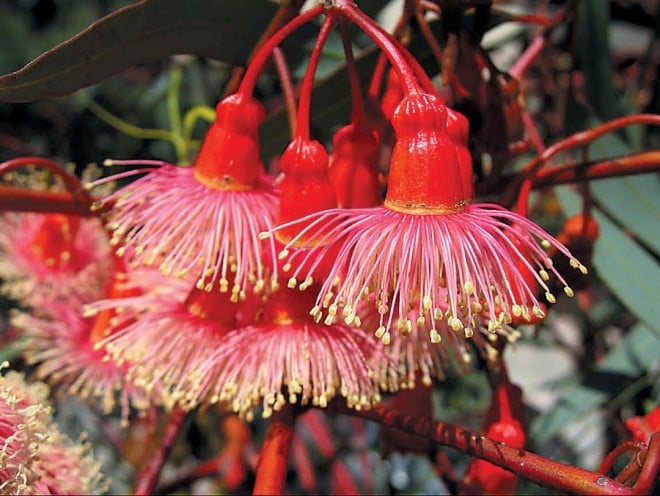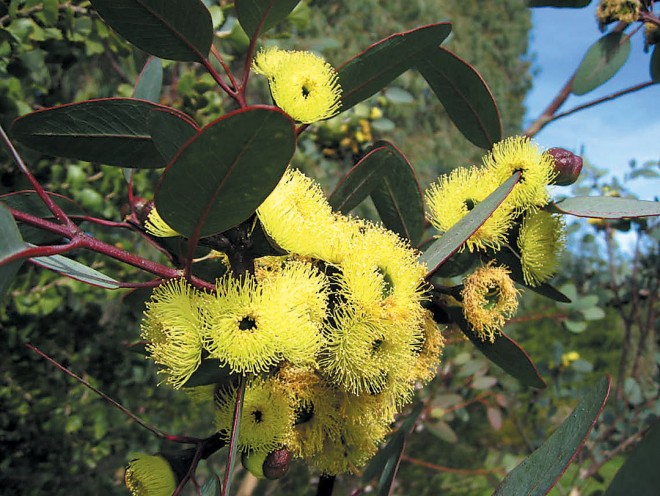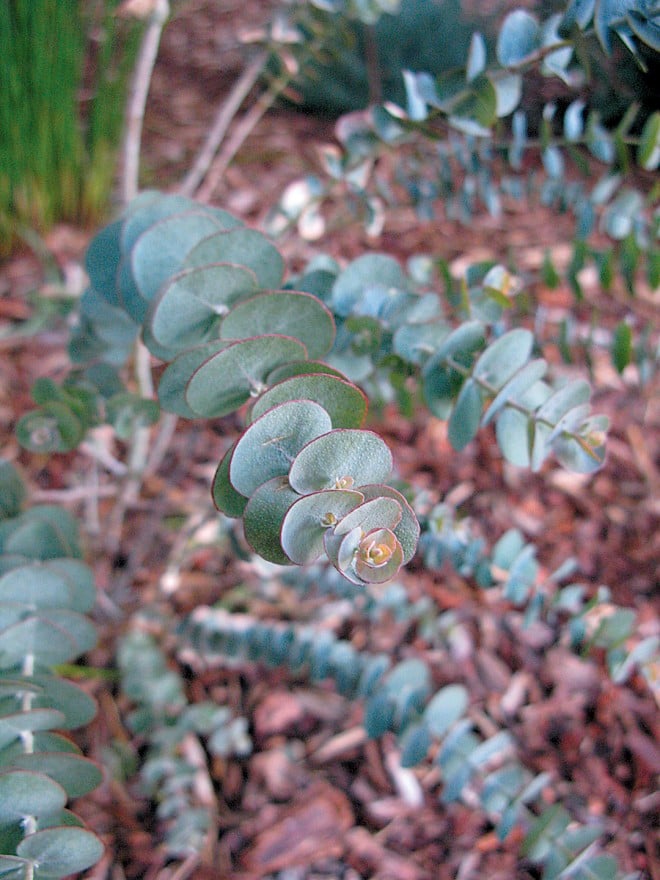
Small Eucalyptus for Western Gardens

Contributor

The planting of a tree is a gift, which you can make to posterity at almost no cost and with almost no trouble, and if the tree takes root, it will far outlive the visible effects of any of your other actions, good or evil.
George Orwell, 1946

Of all the foreign trees that have affected our landscape, eucalypts are undoubtedly the foremost, but, since their introduction into the Western United States in the mid-1850s, they have suffered their fair share of controversy. They were brought from Australia, where all but a few species are endemic, to be grown as horticultural oddities for the nursery trade, then later as promising forestry trees and possible saviors of a forecasted timber drought. The promotion of the genus by private landholders, commercial firms, and state and federal agencies over the last 150 years has resulted in landscapes in the West that are dominated by only a few species. In the regions where they are now conspicuous landscape features, they are either admired as aesthetically valuable heritage trees and monarch butterfly habitat, or demonized as America’s largest weeds.

Due to the well-documented, ecologically damaging characteristics of the few most commonly planted forestry species, primarily blue gum (Eucalyptus globulus), other eucalypts are regularly overlooked during the selection of plants for residential and commercial landscapes. The idea that these trees are all massive, fire-prone exotics— aggressive growers that overwhelm native plants and lower the water table—has made them so unpopular that they have almost completely disappeared in recent years from nurseries in the West.

The genus Eucalyptus, however, is large and diverse. With over 700 species, according to the most recent formal classification, eucalypts exhibit a great range of adaptations to different environments; they rival other large tree genera (eg, Ficus, Pinus, or Quercus) in expressing a variety of mature tree sizes. Many species never exhibit any of the problematic characteristics so commonly, and incorrectly, attributed to the entire genus.

Drought-tolerant eucalypts from desert and mediterranean climates of Western Australia rarely grow larger than small trees or large shrubs, shed little, if any, bark, and seldom reproduce in cultivation; they do, however, offer large, brilliantly colored flowers and attractive foliage. Many of these trees are rare in their native habitats and some are critically endangered. These species are the focus of this article—those whose planting should be considered as appropriate as that of Arctostaphylos, Ceanothus, Protea, and Grevillea; they deserve an opportunity to enhance the gardens, parks, and public landscapes of the Western United States.

Mallees
A small, multi-stemmed species of Eucalyptus is usually referred to as a “mallee” in Australia. Such species have a number of characteristics that make them valuable horticulturally, including interesting foliage, beautiful flowers, and fascinating bark. Because of the dryness of the habitats in which they evolved, they tend to be extremely drought tolerant, with evergreen, sclerophyllous, often wax-covered leaves, which appear in different shapes as the plants mature. The bluish gray leaves of many mallees, including the commonly planted silver dollar tree (E. pulverulenta), are interesting and attractive enough to be regularly used by florists in cut flower arrangements. Depending on the species, mallees produce flowers ranging in size from smaller than a dime to larger than a silver dollar, with brilliantly colored stamens in vibrant yellows, vivid pinks, or stunning reds. Some sport beautiful reddish brown to salmon-colored bark of varying textures and patterns, including small vertical rolls that run parallel to the stems. Mallees are relatively easy to cultivate, propagate readily from seed, are hardy in moderate frosts, and respond well to pruning.

Three mallees with a mature height of six to twelve feet can be grown for their particularly attractive leaves and bark. Tallerack (Eucalyptus tetragona, syn. E. pleurocarpa), book-leaf mallee (E. kruseana), and round-leaved mallee (E. orbifolia) all occur in the wild in desert and mediterranean climates of southwestern Australia. All three species make eye-catching specimens with their opposite, distinctively grayish blue, silvery leaves. Tallerack is so covered with wax that it has nearly white leaves, stems, buds, and fruit. Book-leaf mallee’s smaller, orbicular leaves wrap around and stack tightly together on drooping stems. Round-leaved mallee, which is rare and endangered in the wild, offers slender, reddish brown stems with thin bark that peels vertically in fine cinnamon stick-like curls, contrasting beautifully with the tree’s silver leaves.
Three other small, sprawling eucalypts with particularly striking and unusual flowers are red-cap gum (Eucalyptus erythrocorys), bell-fruited mallee (E. preissiana), and silver princess (E. caesia subsp. magna). The name Eucalyptus is derived from the Greek words eu, meaning “well,” and kalyptos, meaning “covered,” referring to the flower buds, which are covered by a woody cap that falls off as the flowers open. Of all the eucalypts, none has a more brilliantly colored and prominent bud cap than red-cap gum, which sometimes goes by its aboriginal name, illyarrie. This spectacularly ornamental species, commonly grown in many areas of Australia, has a bright scarlet, four-lobed cap that is shed during flowering to expose four clumps of lemon yellow stamens. Bell-fruited mallee is an open, sprawling shrub with golden yellow flowers, sometimes as large as a silver dollar, shiny green, leathery leaves, and ornate, bell-shaped fruit. Rare in the wild, silver princess develops weeping, powdery white branches, from which hang flowers that combine crimson red filaments with yellow anthers.
Mottlecah (Eucalyptus macrocarpa) and four-winged mallee (E. tetraptera) both grow to about eight feet at maturity and are particularly distinctive for their large leaves and enormous, colorful flowers. With its wax-covered, silvery white, egg-shaped leaves, mottlecah rarely achieves a stature greater than that of a low-growing, depauperate shrub, but produces the largest and possibly most spectacular flowers and fruits in the genus. The bright red flowers can reach nearly four inches in diameter, and the fruits resemble white flying saucers. The robust, multi-stemmed four-winged mallee is a novelty wherever it is grown. Its thick, leathery, bright green leaves are prominently beaked at the tip; square, bright crimson flowers twist downwards, with fleshy wings protruding from each corner.

Spectacular Flowers
Coral gum (Eucalyptus torquata) and red-flowering gum (E. ficifolia, syn. Corymbia ficifolia) are larger than the species previously discussed, reaching maturity as small, single-trunked trees, yet no discussion of horticulturally valuable small eucalypts would be complete without their mention. Both are commonly grown in California (red-flowering gum much more than coral gum) and are useful anywhere a drought tolerant, well-behaved, small tree is needed. In addition, they make spectacular floral displays. Coral gum has a crown of lance-shaped, blue green leaves that emanate from orange branchlets; the curious lantern-shaped buds are coral pink with highly ribbed caps. Red-flowering gum is commonly grown, particularly as a street tree in the San Francisco area, yet is rare in the wild; its stout trunks are clad with rough, fibrous, gray brown bark under a dense crown of shiny, dark green leaves. During the summer, this species produces an impressive display of crimson, vermilion, pink, orange, or creamy flowers, which often completely cover the crown. The flower color varies with the selection grown and may be influenced by hybridization with the closely related, white-flowered marri (E. calophylla, syn. Corymbia calophylla).
The species pictured here and described above are only a few of the many smaller eucalypts that can be and are cultivated regularly in Australia and occasionally in the Western US. There are scores of other drought-tolerant mallees and small tree species from Western and South Australia.

Easily Cultivated
With rare exceptions, propagation of Eucalyptus is almost entirely from seed. Most species germinate readily and grow quickly into established plants. Usually, the tiny seeds are germinated in a finely grained potting mix in warm, bright conditions; young seedlings are carefully transplanted to individual pots. Saplings should be planted in an area with well drained soils in the fall; they will establish quickly if they are not allowed to completely dry out in their first winter and are protected from freezing while young. Many mallees can become straggly and develop a poor form with age. Pruning heavily to ground level every ten years or so will produce a vigorous regrowth and a more attractive plant, with renewed flower production. The best way to acquire seeds is from online vendors, such as the Cal Poly Plant Conservatory (www.plantconservatory.calpoly.edu) and Windmill Outback Nursery and Nindethana Seed Service in Australia.

Eucalypts are among the most well-known and recognizable trees in many parts of the world where they have been propagated for timber, fiber, fuel, and windbreaks. The usefulness of the genus in some kinds of forestry is beyond question. The ornamental value of smaller eucalypts is far less well known—especially outside Australia. In fact, most people would not easily recognize some of the species described here as eucalypts. Due to the diversity of foliage, flowers, fruit, bark, and form, and the ease with which they can be grown in dry climates, mallees can be useful and decorative landscape plants. By planting smaller, more well behaved, ornamental species of Eucalyptus, we may finally erase the bad name earned by the large, weedy members of the genus.
Share:
Social Media
Garden Futurist Podcast
Most Popular
Videos
Topics
Related Posts

Ground Up Science for Greener Cities with Garden Futurist Dr. Alessandro Ossola
Spring 2023 Listen to the Podcast here. Alessandro Ossola is a scientist who gets very excited about the challenge of climate change allowing for an

Readying Urban Forests for Climate Realities with Garden Futurist Dr. Greg McPherson
Winter 2023 Listen to the Podcast here. “Going from the mow and blow to a more horticulturally knowledgeable approach to maintaining the landscape. And that

Welcome, Greywater, to the Garden
Summer 2022 Oh, summer: delightful warm air, tomatoes swelling on the vine, fragrant blooms on an evening stroll. When it’s warm and rainless, how is

Big Tree-Data and Big-Tree Data with Garden Futurist Matt Ritter
Summer 2022 Listen to the full Garden Futurist: Episode XV podcast here. We are in an environmental crisis right now in many parts of California











Responses